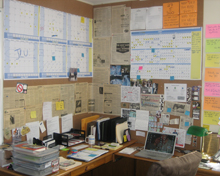 If you’re self-employed like me, wall motivation decorations can do you some good.
If you’re self-employed like me, wall motivation decorations can do you some good.
To keep yourself on point.
To keep yourself motivated.
To keep yourself accountable.
Ever since I was a kid, I’ve been obsessed with wall decorations. From my house growing up to my college apartments to my present office, “no white space” has always been my motto. (I learned everything from my big brother Steve.)
I even lost my deposit once because the landlord complained that when I moved out I left behind “hundreds of holes.”
Woops.
But from a self-motivational standpoint, covering your office walls with personalized, vibrant and positive decorations can actually help you become more successful. Here are a few suggestions:
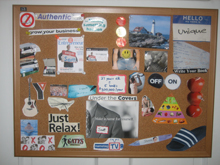 Visualizations. “Act as if you already are the person you want to become and you will eventually become the person you want to become,” said my mentor.
Visualizations. “Act as if you already are the person you want to become and you will eventually become the person you want to become,” said my mentor.
So, think about your long-term goals and dreams. Maybe it’s to own a beach house. Or to achieve a senior-level position. Or to secure an appearance on Oprah. Or to be featured on the cover of a magazine. (This is my Vision Board pictured to the left. Thank you, The Secret.)
Whatever your goal is, you MUST actually, physically, literally, create an image of having already achieved it. Hell, sneak into the CEO’s office and take a picture of yourself sitting in her chair if you have to!
I don’t care. Just do it. I know it sounds ridiculous. But trust me. When your goal comes to fruition, people won’t be laughing – they’ll be applauding.
 Quotations. These are the perfect tools (er, words) to keep you motivated.
Quotations. These are the perfect tools (er, words) to keep you motivated.
Go see my friends at Quote Garden for some great material.
Then grab a few of those giant sticky notes and post several of your favorite one-liners around your office.
The key is to choose quotations that:
*make you think
*make you smile
*make you laugh
…every time you see them.
Choose wisely.
Questions. First, think about the most important questions you need to be asking yourself regularly.
 Then make posters, dry erase boards or signs and hang them high.
Then make posters, dry erase boards or signs and hang them high.
Be sure they can be seen from across your office.
This example is the #1 most important question I ask daily.
Because writing is the basis of all wealth.
 Here’s another one of my favorites.
Here’s another one of my favorites.
Other suggestions are, “How many calls did you make today?” and “Is what you’re doing right now consistent with your #1 goal?”
Personal Mission Statement. The one (and only) thing I took away from The Seven Habits was the section about creating a personal mission statement.
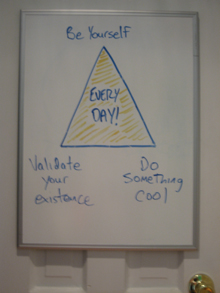 Years later, I still keep my PMS posted to the left of my door. That way I see it every time I leave. I suggest you do the same.
Years later, I still keep my PMS posted to the left of my door. That way I see it every time I leave. I suggest you do the same.
Since you probably can’t read my writing, I’ll just tell you:
Do something cool…
Validate your existence…
And be yourself…
EVERY DAY.
Goals. Take a few of your biggest, most important goals. Post them nice and big – right in front of your face!
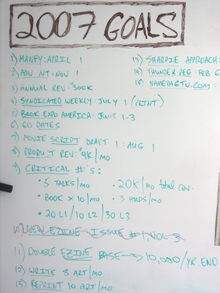 Make sure they’re inescapable from your eyesight so you HAVE to look at them at least three times a day.
Make sure they’re inescapable from your eyesight so you HAVE to look at them at least three times a day.
Odds of you accomplishing your goals will triple. Promise.
And I’m sure you don’t need to hear me preach about goals, but here are a few tips:
*Make them specific
*Make them achievable
*Give them a time frame
*Share them with other people
*Cross them off when accomplished
Accomplishments. Every time an article of mine appears in a print publication, I hang a copy on my wall.
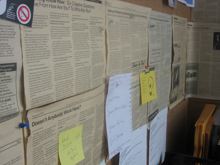 Not because I’m an egomaniac, but because surrounding myself with visual reminders of small victories builds confidence.
Not because I’m an egomaniac, but because surrounding myself with visual reminders of small victories builds confidence.
CHALLENGE: think back to your three best accomplishments from the past year. Find some way to represent them visually, and stick ‘em up there!
Look, guys. I know it seems like a lot of stuff to hang on your wall. But why not? It’s just empty space. You may as well cover it with something productive.
OH, AND HERE’S THE BEST PART: next time a customer or coworker comes into your office, they’re gonna stop and look around.
And they will be amazed.
Because you’ve visually PROVED to them that you’re dedicated to success.
LET ME ASK YA THIS…
What’s on YOUR wall?
LET ME SUGGEST THIS…
Share your favorite motivation decorations here!
* * * *
Scott Ginsberg
Author/Speaker/That Guy with the Nametag
www.hellomynameisscott.com
add to del.icio.us * digg it! * email this post
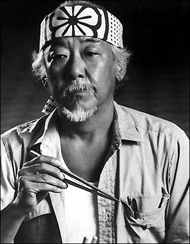 You’re self-employed.
You’re self-employed.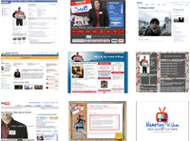 Are you a friend of The Nametag Network?
Are you a friend of The Nametag Network?
 Creative professionals MUST exist in a creative environment.
Creative professionals MUST exist in a creative environment. 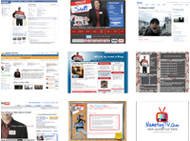 Are you a friend of
Are you a friend of  The most successful artists, innovators, entrepreneurs and inventors of the world aren’t One Hit Wonders.
The most successful artists, innovators, entrepreneurs and inventors of the world aren’t One Hit Wonders. HOT BODY #1
HOT BODY #1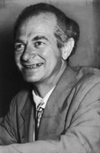 HOT BODY #2
HOT BODY #2 HOT BODY #3
HOT BODY #3 HOT BODY #4
HOT BODY #4 HOT BODY #5
HOT BODY #5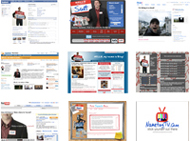 Are you a friend of
Are you a friend of 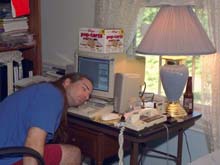 You’re self-employed.
You’re self-employed.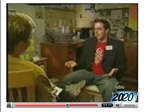 Are you the luckiest person you know?
Are you the luckiest person you know? Sticky notes.
Sticky notes. Are you the luckiest person you know?
Are you the luckiest person you know? My mastermind group used to meet in a conference room at an ad agency.
My mastermind group used to meet in a conference room at an ad agency. Are you the luckiest person you know?
Are you the luckiest person you know?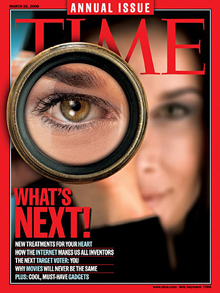 My first job out of college was selling couches at a
My first job out of college was selling couches at a 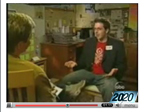 Are you the luckiest person you know?
Are you the luckiest person you know? * * * *
* * * * If you’re self-employed like me, wall motivation decorations can do you some good.
If you’re self-employed like me, wall motivation decorations can do you some good.  Visualizations. “Act as if you already are the person you want to become and you will eventually become the person you want to become,” said my mentor.
Visualizations. “Act as if you already are the person you want to become and you will eventually become the person you want to become,” said my mentor.  Quotations. These are the perfect tools (er, words) to keep you motivated.
Quotations. These are the perfect tools (er, words) to keep you motivated.  Then make posters, dry erase boards or signs and hang them high.
Then make posters, dry erase boards or signs and hang them high.  Here’s another one of my favorites.
Here’s another one of my favorites. Years later, I still keep my PMS posted to the left of my door. That way I see it every time I leave. I suggest you do the same.
Years later, I still keep my PMS posted to the left of my door. That way I see it every time I leave. I suggest you do the same. Make sure they’re inescapable from your eyesight so you HAVE to look at them at least three times a day.
Make sure they’re inescapable from your eyesight so you HAVE to look at them at least three times a day.  Not because I’m an egomaniac, but because surrounding myself with visual reminders of small victories builds confidence.
Not because I’m an egomaniac, but because surrounding myself with visual reminders of small victories builds confidence. 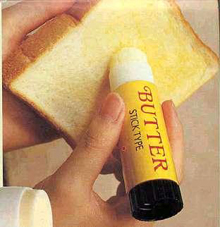 Read part 1
Read part 1